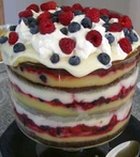|
British Dessert English Trifle*
Cake: use your favorite cake recipe—yellow, white, sponge, or pound cake. Fruit: while the cake is baking, peel, slice, and pit peaches. Toss with ½ C sugar and chill. Rinse and hull the strawberries. Toss with ½ C sugar and chill. Custard: in a heavy saucepan or a double boiler, bring milk almost to a boil. Beat the 2 eggs and 2 extra yolks till lemon colored, and add 1/2 C sugar. Pour half of the nearly boiling milk into the egg mix, stirring vigorously. Then pour the egg-milk mix back into the saucepan with the rest of the milk. Continue heating and stirring constantly (don't let eggs curdle). When ready, the custard will have the consistency of heavy cream and be able to coat a wooden spoon. Remove from heat and add vanilla and almond extracts and sherry. Assembly: Cut the cake into 1/2" slices. Arrange slices over bottom and sides of a large crystal or glass bowl. Cut additional slices if necessary to fill in any wholes. Layer in the peaches to the bowl and pour in the custard, almost to the top. If there are any remaining cake slices, spread them with strawberry preserves and layer them, jam-side-up on top. Arrange the strawberries and top with whipped cream. Chill till ready to use. * For a delicious but less time-consuming version see O'Connor Family Trifle under Ireland. |
Tips & Glossary Clotted Cream: a thick yellowish cream made from unpasturized cow's milk. You can make your own, although it's hard to find unpasturized cream in the U.S. Still, you'll find 3 recipes under Scones. All use pasturized cream; try to avoid "ultra" pasturized. Ploughman's Lunch: sounds romantic, like a peasant dish from medieval times, but it's a marketing gimmick from the 1970's! It's become a popular lunch in Britain now: a piece of bread, hunk of cheese, with onion, gherkin, and an apple. Our Ploughman's Soup is a take-off on that name. Roux: (“roo”), paste-like mixture of melted butter and flour, into which liquid is gradually added. Used as a thickening agent for soups and all classic French sauces. Basic Roux: melt 1 part butter and add 1 part flour. Stir continuously till it becomes paste-like. Slowly add whatever liquid your recipe calls for. Tea Time: Afternoon tea became fashionable in the mid-1600's. A light snack with sandwiches and sweets, it's served from 3-5 in a sitting room. High tea, is a light meal served from 5-6 in a dining room. ("High" because the dining table is higher than the low ones in a sitting room.) Yorkshire Pudding: from the northern county of Yorkshire, originating in the early 1700s when flour was more readily available. A pancake like batter is spooned into the drippings of a roast as it cooks. Eaten alongside the roast or as a separate course.
|

